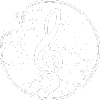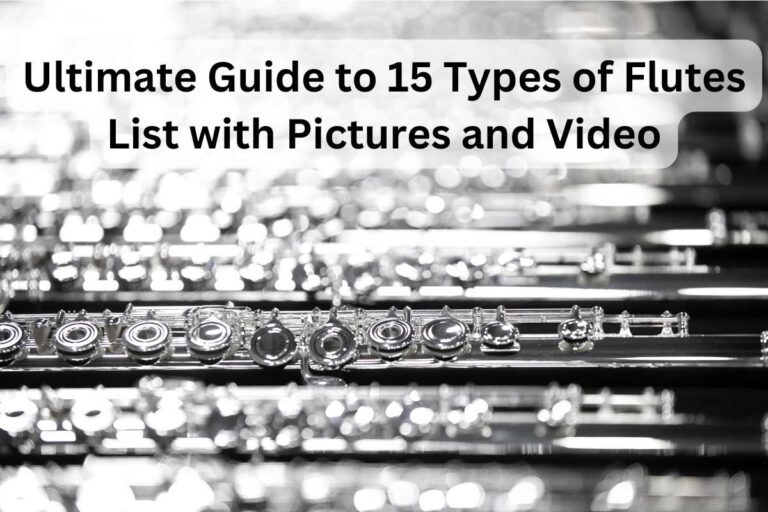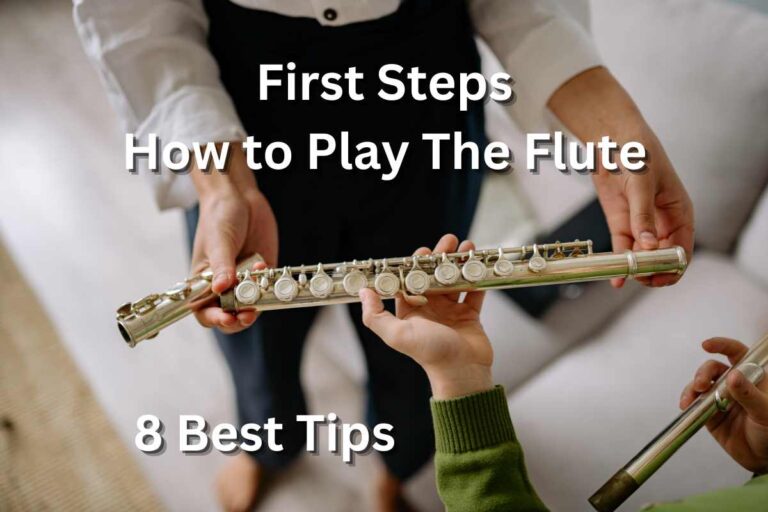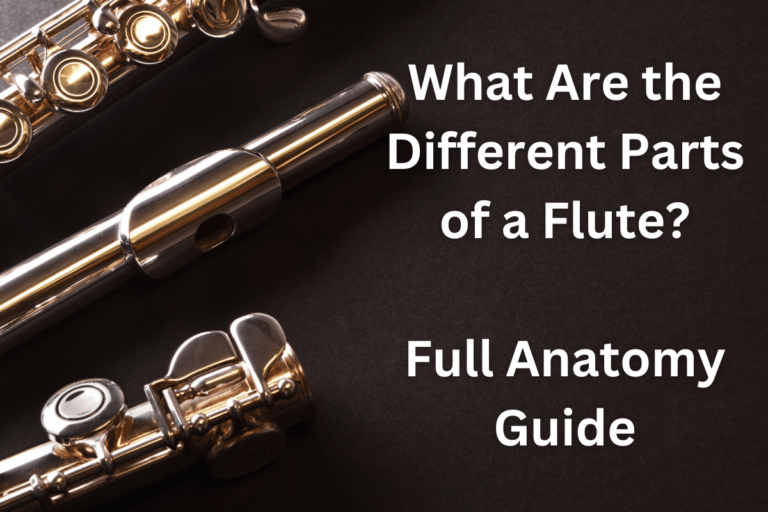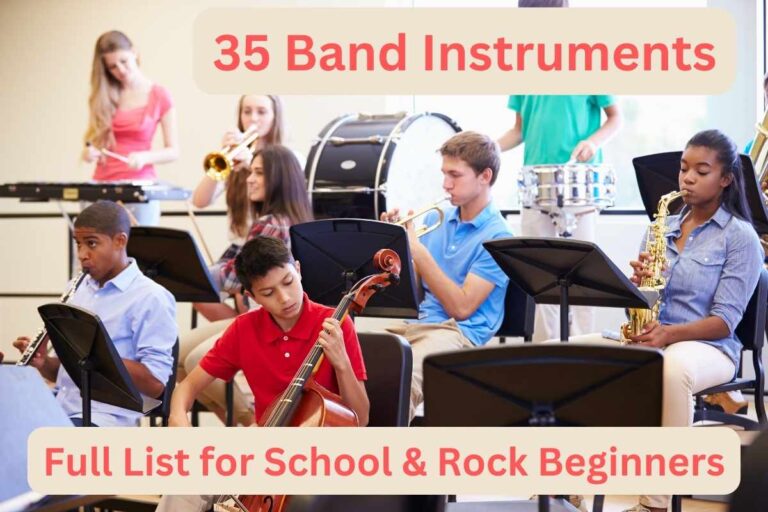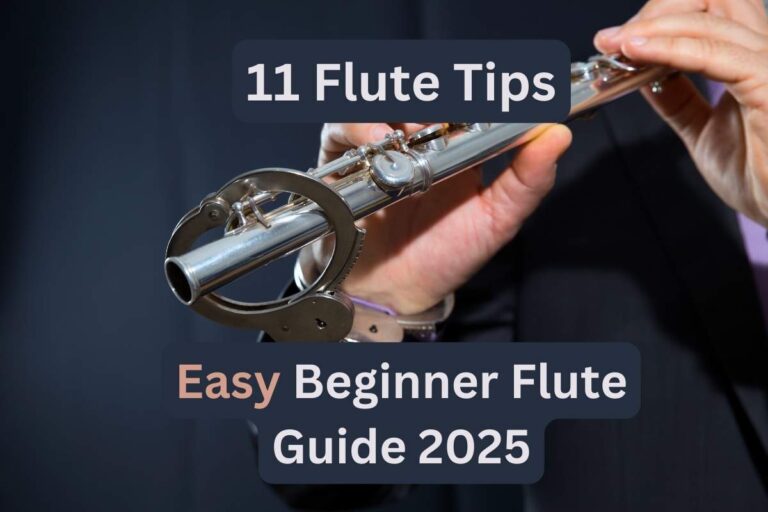17 Different Types of Trumpets — Pick The Best Brass Horn Of Trumpet Family
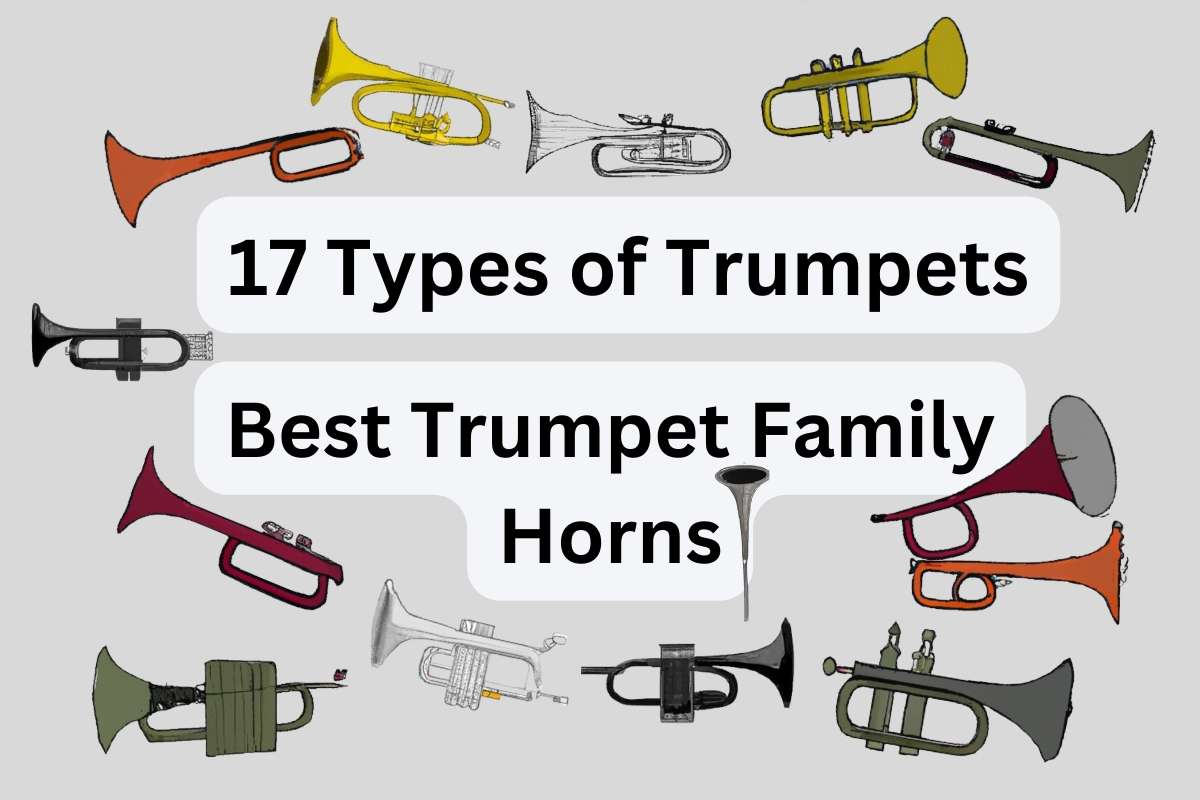
17 types of trumpets, including Bb trumpet, common types of cornets(Bb, Eb, C), piccolo trumpets, and Bb pocket trumpet – find your next brass instrument.
I’ll describe the unique characteristics and discuss how they foster musical expression.
What Are the Different Types of Trumpets?
The trumpet family includes trumpets, piccolos, cornets, and flugelhorns — all these use mouthpieces (with a bowl-shaped inside part) for bright and clear sound.
While strings often have standard tunings, the winds and brass vary widely
- Flutes, oboes, and bassoons are typically in C
- Clarinets come in both B♭ and A and
- Saxophones in both B♭ and E♭
- The French horn is in F and Bb
- The trombone is Bb with a C reading (somewhat confusing!)
- While the tuba can be in B♭, C, E♭, or F, requiring different fingerings for the other keys.
Trumpets are somewhat unique in this mix — No matter the trumpet’s pitch, its fingerings and how they read from the harmonic series stay the same. That makes it a bit easier to learn and play the different types of trumpets.
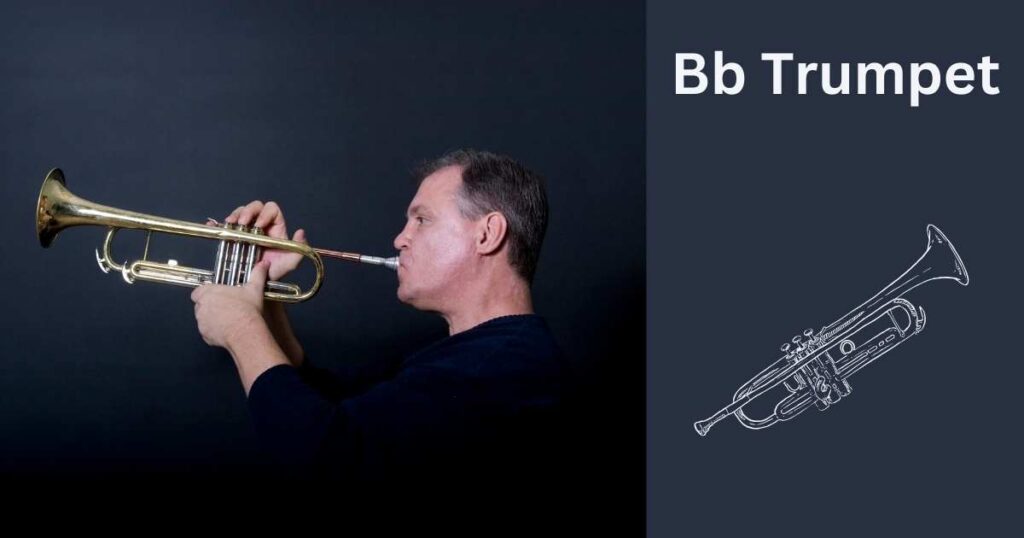
1 Bb Trumpet – Common Trumpet
Most of the trumpets are transposing in a key of Bb. That means that if you see a written “C” in your sheet music, you will play a B♭ in concert pitch (a whole step lower).
I mean, if you are going to play any of the trumpet repertoire or play in any ensembles you’ve got to learn it in Bb. Amazingly, almost all of the literature is written for the Bb trumpet.
Learn the standard fingering (a written C is open), and you’ll be able to transfer to other brass Eb cornet, F mellophone, or C trumpet!!
Prices
$650 – $20,000
Brands
Yamaha, Bach, Getzen, Selmer, Jupiter, Conn, Holton, King, Monette.
For use in jazz music or ensemble bands, play the standard Bb trumpet and learn to transpose using the corresponding fingerings.
However, if you want to play in concert pitch (for solo or orchestra), you could play a C trumpet. Then, if you play written C, the actual sound is the concert C — no need to transpose. (Read my other post with the “15 Best Trumpet Beginner Tips”)

2 C Trumpet — Orchestral Transposing Instrument
The C trumpet is tuned in the key of C and is especially prevalent in American orchestras and conservatories.
It’s the classical music instrument of choice, the C trumpet is in a “concert pitch” like the piano, guitar, violin, and flute — also concert pitch. Thus, it is easier to play with those instruments without transposing a third.
Choosing a C trumpet — try them out before purchase!
Prices
$1500 – $13,000
Brands
Yamaha, Bach
C trumpets are very finicky, and finding the just right one that will cut it for one’s playing style and sound is impossible. Yamaha and Bach are very common brands with Yamaha Chicago C and Bach Chicago C standards models in many orchestras. (Read more about “10 Best Trumpet Brands”!)
3 E – Eb – D Trumpet
The E, Eb, and D trumpets offer unique opportunities for performances in classical and Baroque pieces.
The E trumpet is a rarity, often found as a convertible instrument, like Stomvi’s E trumpet, which can also be configured for F and G. Yamaha offers an from D to Eb convertible model as well.
E trumpet excels in pieces with challenging passages in the key of E, such as the Toccata from Pulcinella or the original key of the Hummel Concerto. These instruments provide precision and clarity in keys that can be difficult to navigate on a standard Bb or C trumpet.
Most of their use is by orchestral musicians seeking the added security of a different keyed trumpet.
Prices
$1,500 – $13,000
Brands
Yamaha, Bach
D trumpets are predominantly used for Bach and Baroque music. Their bright, focused sound suits the stylistic demands of these genres. However, many find an A piccolo trumpet handles these pieces just as effectively, if not better.
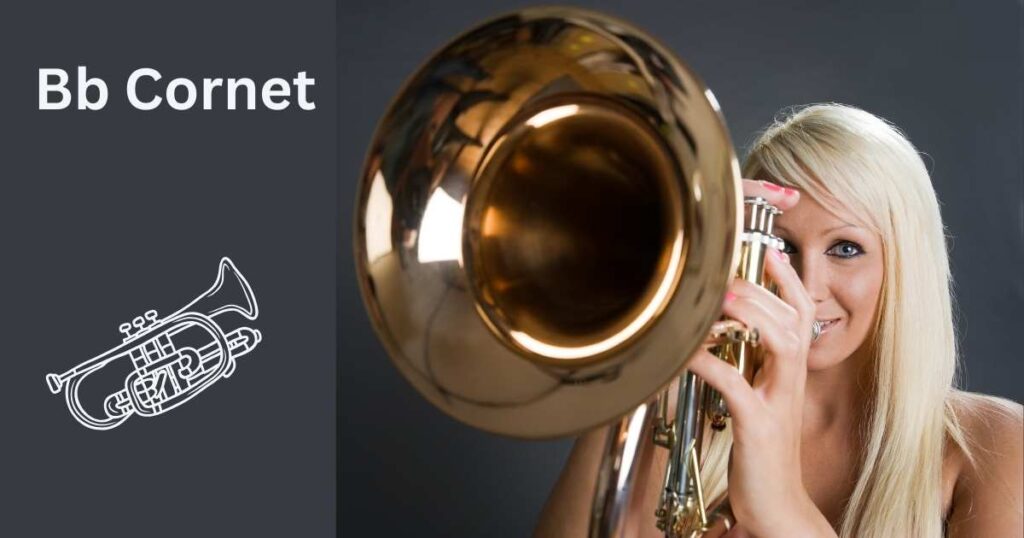
4 Bb – Eb Cornet — Great For Trumpet Player
In concert bands and wind ensembles, sometimes trumpet players double on cornets since many arrangements feature three parts written for cornet and two for trumpet.
Cornet parts are more melodic and technical for a warmer, darker sound on the cornet for a more lyrical and mellow quality.
Most beginners play the B♭ cornet, and therefore, most of the tutorial material for the basics applies to that instrument.
Prices
$650 – $13,000
Brands
Yamaha, Bach, Besson
The Bb cornet is similar to the trumpet (tho more compact), but the sound produced is very different. It’s a great instrument of practice and experimentation and plays a viable role in band settings.
5 Cornet In Pitch Of C
The C cornet is extremely useful for the orchestra, where the Bb cornets often struggle with complex key signatures (Imagine navigating through parts with six or seven sharps).
Prices
$1650 – $16,000
Brands
Yamaha, Bach, Besson
C cornets are game-changers for orchestral musicians in complex pieces (Tchaikovsky’s ballets) when the transpositions to A and E are much more accessible with a C cornet.

6 Flugelhorn For Mellow Tone
Most jazz bands enjoy the flugelhorn because of its mellow, fluffy sound, which makes it great for ballads and smoky jazz performances.
In professional ensembles, the “utility” player often doubles on flugelhorn (third or fourth chair).
Most players in a professional ensemble play the flugelhorn, still, very few specialize in it, except a short list of real pros — Chuck Mangione, Clark Terry, Chet bake and Claudio Roditi In Pro Bigbandsr.
Prices
$500 – $15,000
Brands
Austin, Jean Paul, Eastman, Bach, Yamaha, Kanstul, Blessing, Conn
Flugelhorn iss a fun and rewarding instrument, similar to the trumpet, so that any trumpeter can switch over to it quite readily.
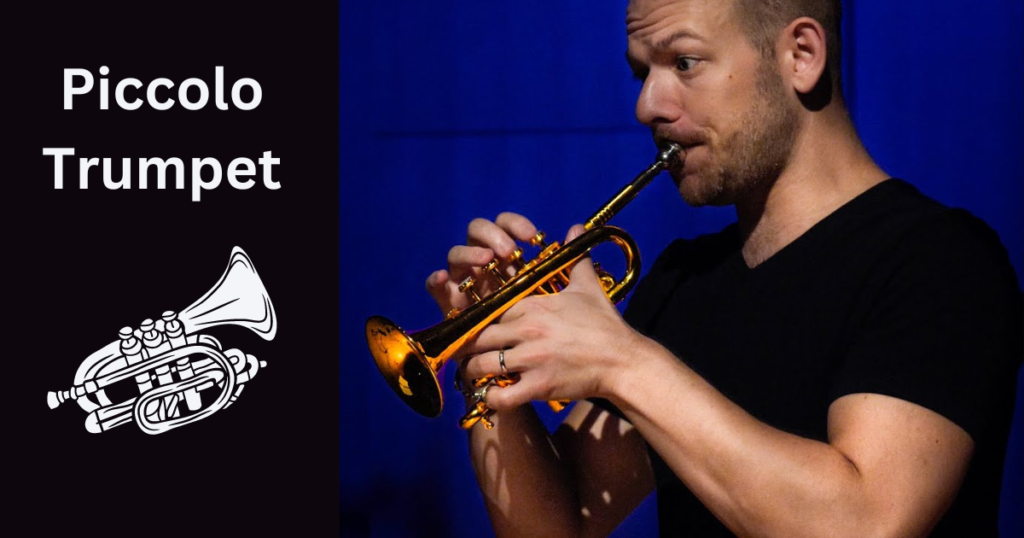
7 Brighter Piccolo Trumpets of Different Configuration
They are ideal for the most challenging Baroque parts pieces but also work well for some higher modern trumpet parts.
They have four valves for greater accuracy in the high range. Three-valve piccolo trumpets (like Getzen’s model) are not effective and pros hardly ever use them.
Piccolo trumpets are not cheap for nothing!
These horns are difficult to produce and require an extremely high level of craft. There are more than enough poorly made Chinese copies that simply flood the market, but again, AVOIDE them like the plague.
Well-quality piccolos offers a joyful playing experience and a level of detail with respect to playing precision and clarity of tone.
In contrast to the Bb trumpet, the piccolo trumpet requires delicacy and control, NOT blowing power. When you blow too hard into a piccolo trumpet — that high note becomes flat again!
Prices
$1500 – $10,000
Brands
Gemeinhardt, Yamaha, Bach, Pearl, Jupiter
The piccolo trumpet is not for the faint of heart — it is challenging even for the pro trumpeters because it requires a dainty touch and technique.
8 G/F Trumpets — More Types of Trumpets
‘G’ and ‘F’ trumpets are curious but most overlook these members of the trumpet family. This is because they have specific uses (more in Baroque music) with their brighter sound and higher pitches — easier for transposition.
It offers the high-register “security” of piccolos but with a somewhat rounder tone, ideal for Stravinsky “Pulcinella”, Bach “Cantata 51”, or Mahler passages which demand a strong, robust, yet highly high sound on the trumpet.
Prices
$1150 – $14,000
Brands
Yamaha
G and F trumpets are the best for the university professor and the pro orchestral or solo player (or the severe enthusiast for historical performance).
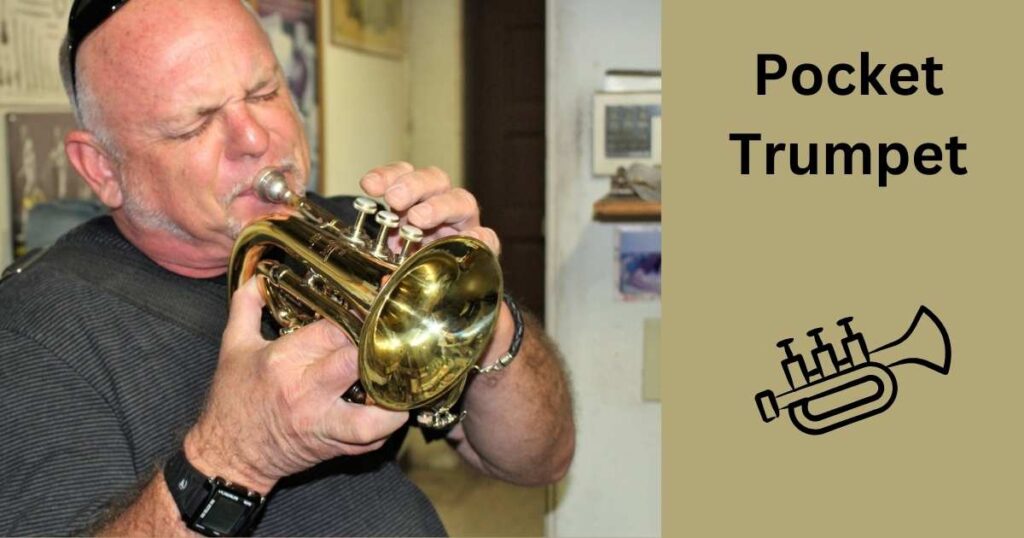
9 Pocket Trumpet
The pocket trumpets are, for the most part, novelty instruments, but they are pretty valuable to musicians on the go.
Pocket trumpets are best for practising valve techniques (tho consume more valve oil), improvisation, and playing scales and arpeggios, but are small and are ideal when do not want to carry your main horn.
Prices
$400 – $3,000
Brands
Mendini, Austin, Schagerl, Stagg, Jupiter, CarolBrass
Not all pocket trumpets are equal! Some models of pocket trumpets do not have a 1st slide and are not as reliable in their intonation, especially in the low range.
Above the staff, players can find that intonation and resistance frequently become problematic. Don’t press your embouchure, and continue good playing habits even with the smaller instrument.
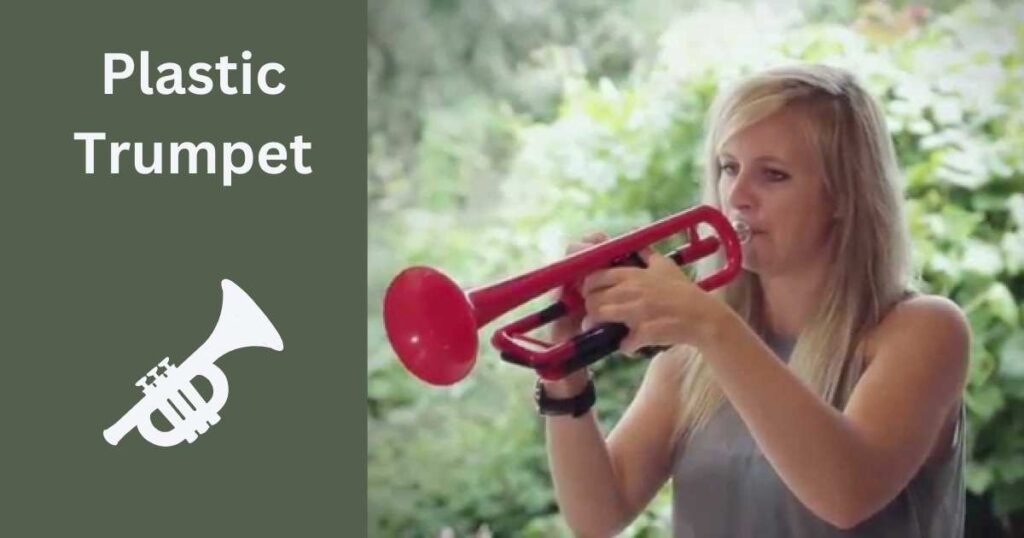
10 Plastic Trumpet pTrumpet and Others
Although they are not as resonant as metal trumpets, the plastic trumpets are a blast and very fun to play!!
They are genuinely in pitch, lighter, practically indestructible, and an excellent addition to any musician’s collection for casual (or outdoor) use.
The action of a plastic trumpet is not as finely precise as a brass trumpet, but it is better than the cheap (less than 500$) Chinese no-name horns.
Although plastic is a resonant material, it will not resonate as profoundly as brass (copper and zinc alloy) will.
Since they are light and durable, the plastic trumpets are suitable for younger children just learning to play.
Prices
$75 – $250
Brands
pTrumpet, Tromba, Pampet
Plastic trumpets are not the primary instrument for a starter! Switch to a student model as soon as your child can hold the weight of a brass horn.
They make great, durable alternatives for casual playing and fun instead of serious practice. They’re also great for taking you to the beach, park, or any place where you can damage a regular trumpet.
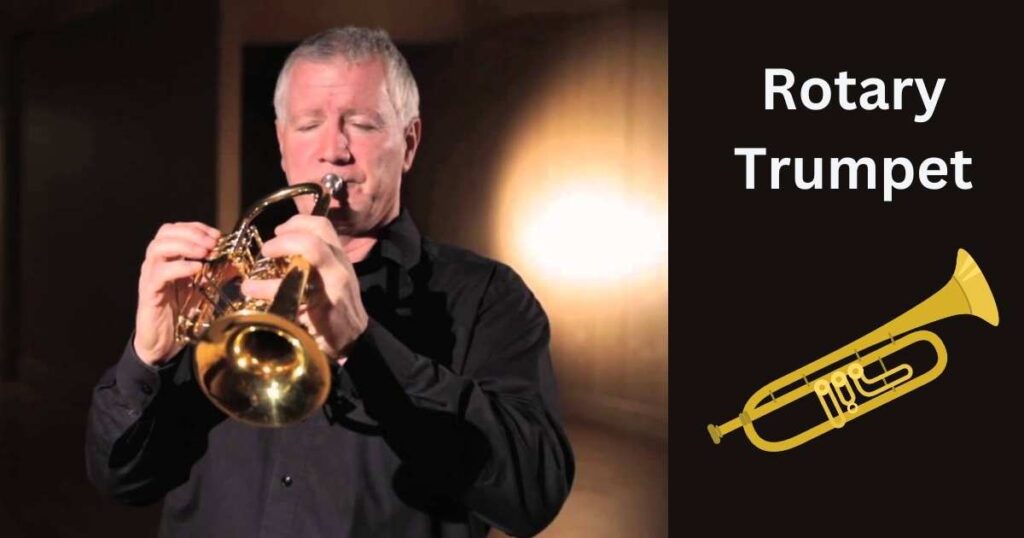
11 Rotary Valve Trumpet
This is a trumpet with rotary valves rather than piston valves.
Rotary trumpets are more conical, with a larger lead pipe and bell diameter than piston trumpets. The slides on the rotary trumpets, more often than not, are of a less curved nature, which gives them quite a distinct form and sound.
The valve block is closer to the mouthpiece on valve trumpets, which disrupts the airflow when you depress valves, resulting in a unique sound.
Prices
$2650 – $8,000
Brands
Yamaha, Schiller
Rotary trumpets have a broader, deeper, and resonant timbre mainly for classical music and orchestra — such a mellow, abundant sound blends like magic in an ensemble.
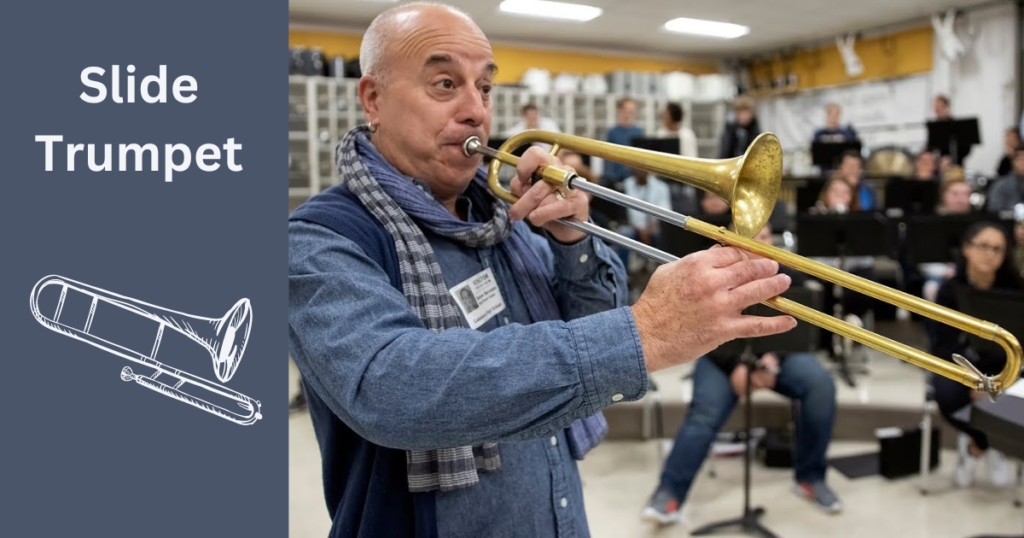
12 Slide Trumpet — Rare Types of Trumpets
This slide trumpet combines the trumpet and the trombone. The pitch starts on C in the first position and extends to D with an all-way-out slide — quite like how a soprano trombone works.
It is a much less forgiving horn, as you need to manage the slide and control intonation!
Prices
$650 – $10,000
Brands
John Packer, Schiller
The slide trumpet usually has a huge .460″ – .470″ inches bore, a long, tapered lead pipe inside the upper tube, and a standard trumpet mouthpiece.
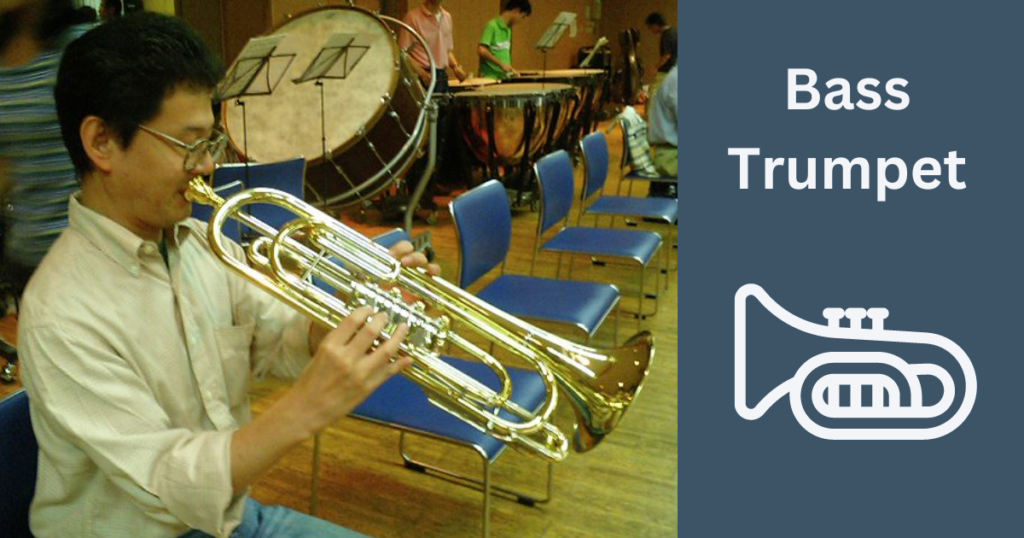
13 Bass Trumpet — Rare Types of Trumpets
The bass trumpet tubbing is extremely tight, tighter than the marching baritone, within an even smaller bore — many bass trumpets have as many (or even more) wraps as the French horn has.
Bass trumpets in B♭ is smaller in bore and bell than other low brass. Their bores are much more cylindrical, which forms a distinctive sound.
Prices
$850 – $3,500
Brands
Jupiter, Schiller, V.F. Cerveny
A bass trumpet will add a rich lower register to a standard trumpet section.
If you’re considering playing a bass trumpet, check FIRST with the director! Most ensemble settings will require a standard trumpet or trombone rather than a bass trumpeter
14 Silent Brass
The system gives you (as a trumpet player) the alternative of practicing quietly (in isolation) yet hearing yourself through headphones!!!
Silent Brass system is an excellent tool for college bands and those living in dorms and apartments to practice quietly — more opportunities to practice without disturbing your neighbors. Use decent headphones for the best experience.
Prices
$200 – $300
Brands
Yamaha
While Silent Brass does a great job of muting the sound with little to no loss of feel for short-term practice — it is not a substitute for unmuted practice!!
Some players have reported endurance, range, and overall strength losses when working strictly through it. No practice mute can ever finally preserve the natural playing characteristics of your instrument.

15 Herald Trumpet
Military bands of various world countries mainly use the herald trumpet and its ceremonial and visual functions.
It is a spectacular instrument for parades and ceremonial uses, like the Kentucky Derby or a Medieval Times show.
Prices
$2000 – $6,000
Brands
Bach, Yamaha, King
Gerald trumpets have long, straight tubing for (extra) projection and hanging banners or flags, which explains the loops soldered to their sides.
It is a bit long and hard to hear yourself, but facing a wall when you practice helps!
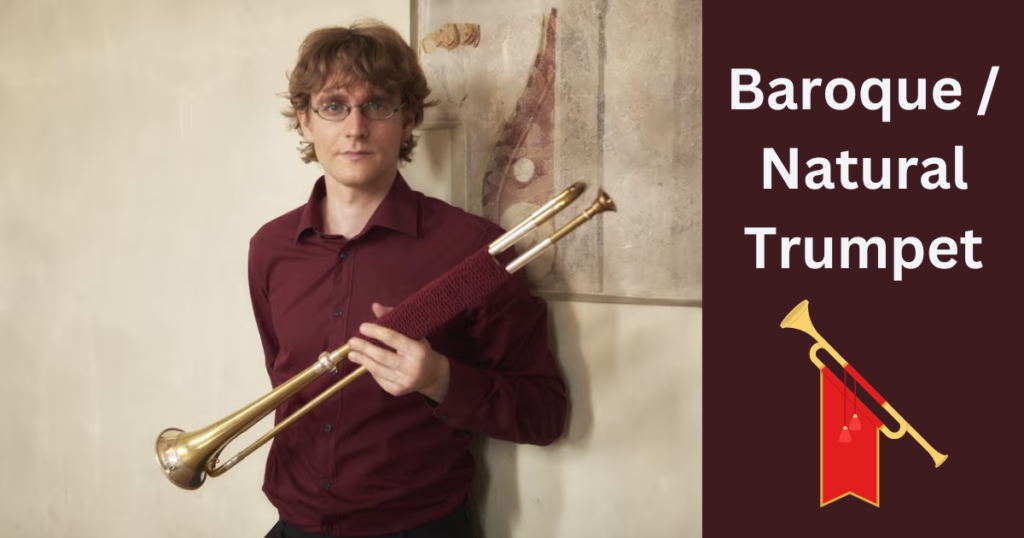
16 Natural Trumpet and Baroque Trumpet
In the Baroque era, Natural trumpets were long tubes folded onto themselves (like paperclips) and wrapped around once with NO holes, vents, or slides!
You would manipulate your lips to hit different notes since the instrument can not play a chromatic scale and plays in the key in which it was set.
A natural trumpet cannot tune to the minor scale, but it can produce part of some minors — in a key of C, you play only D minor, E minor, and A minor.
Prices
$2100 – $4,500
Brands
Baroquetrumpet, Nartiss, Bosc, BfB
Baroque trumpets have small holes to help with tuning and note stability, whereas natural trumpet has no vent holes. The vent holes fix F# and A notes and ease E, G, and C so you get accurate pitch (without lots of daily practice).
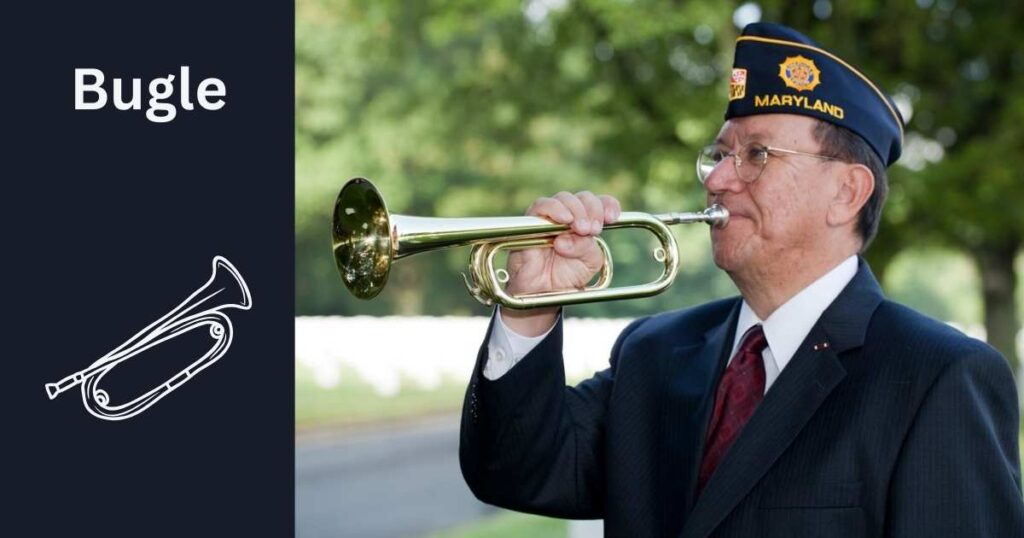
17 Bugle
The bugle (valveless horn) brings civil war battlefields and scout camps to mind. This simple instrument makes a great noise, hence the centuries as a military and ceremonial mainstay!
Bugle tubing flares steadily into the bell shape, whereas the tubing of a trumpet remains uniform until reaching the bell.
Bugles stick to the harmonic series and play a set of pitches that become closer together as you play higher. For instance, a C bugle gives the following notes: C4, G4, C5, E5, G5, and Bb5, C6.
Prices
$100 – $300
Brands
CarolBrass, U.S. Regulation Bugle, John Packer, Dynasty
Bugles are in use in a military setting as a way of passing signals. Various military branches use different calls by the bugle to signal different activities
- Air Force generally plays the National Anthem in the evening after Retreat
- Navy sounds the National Anthem in the morning and a “Retreat” in the evening, along with “Carry On” signals
- Army uses bugle calls that include Assembly, Reveille, Mess Call, and Retreat.
Conclusion: Different Types of Trumpets
Each trumpet has its own unique features and characteristics.
From the commandingly brilliant Bb trumpet to the mellow richness of the flugelhorn — these are instruments of emotion!
Each trumpet “speaks” its story, from the battlefield origins of the bugle to the sophistication of the piccolo trumpet.
Whether you are a pro musician or an eager amateur — knowing the features helps you pick your next horn!! (Read my “How To Hold a Trumpet” guide)
